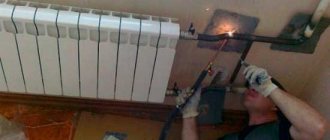There is a riser in the water heating system in every house (having 2 floors or more) and apartment. In the absence of other heating methods, without these communications a comfortable life would simply be impossible. But the heating system needs periodic repairs. For example, to replace a battery or rearrange it to hide it, it is necessary to block the access of coolant to it. Doing this in a private home is not difficult. You are the owner yourself and can do this at any time convenient for you. What about in an apartment building? How to turn off the heating riser in this case? This will be discussed in the article.
Why is coolant in the system in summer?
It sounds quite paradoxical, but steel and cast iron elements of heating systems are damaged by rust to a lesser extent when there is coolant inside. Why is this happening?
The answer lies in the following reasons:
- Water or other coolant in the heating system (meaning a closed heating system) is located inside a closed volume. In this case, the internal cavities do not communicate with atmospheric air. Corrosion occurs when dissolved oxygen in water comes into contact with metal inside the network,
Photo of a cut heating pipe with corrosion
- Due to the fact that the system is cut off from the environment, water (or other coolant) quickly loses dissolved oxygen, because it will completely react with the iron atoms inside the pipes and batteries. After this, the oxidation process stops, because there is no free dissolved oxygen left in the coolant and the heating system ceases to corrode,
- Thus, the heating system from the inside practically does not rust, unlike pipelines for hot and cold water. If the coolant is removed from the network, then moist air remains inside, which contains about 20% oxygen. Therefore, when there is no water inside the network, steel and cast iron elements are subject to rust.
forced paid dismantling of heated towel rail pipes is the Criminal Code right?
Recently we became happy hostages of a mortgage, but not even half a year had passed when a plumber came from the management company to check the hot water supply, after which they gave a decree on the need to dismantle the pipes of the heated towel rail, and this work would cost: 6,000 rubles for the work of the plumber and 1,000 rubles for the materials. Background: hot water in the house heats up very slowly (often it is necessary to flush 100 liters down the drain before the water warms up to a sensibly warm level). House born in 86, series P-44. It is logical that appeals were received to the management company and a plumber visited all apartments on this hot water riser in order to identify and further eliminate the cause. Some or other violations were eventually identified in a good half of the apartments, but that’s not what we’re talking about.
The structure of the passage of water through the hot water supply system into our apartment: 1). through the meter to the taps (no complaints about this) 2). then the hot water flows through a common pipe, where the movement of water is blocked (by a valve, which apparently does not turn anymore, at least moderate effort is not enough, and hammering with a hammer is dangerous - the pipe may leak) and the water goes to the pipe under the heated towel rail (along walls in the bathroom and on the wall farthest from the wiring) and from the heated towel rail it already flows back into the general hot water supply (there are also 2 valves on these pipes, which no longer turn with moderate effort)
Despite the fact that the pipes of the heated towel rail could become clogged with rust inside and really poorly pass water into the general hot water supply, the following question interests us:
1). installation of this structure was already present when we purchased the apartment, respectively, because This structure grows from a common hot water supply system, and only the management company could turn off the hot water for its installation. Why are we now being asked to pay 7,000 rubles for the dismantling of this structure? 2). supposedly the layout of the house provides for a “heated towel rail” that goes under the sink right behind the wall in the bathroom (why is there a heated towel rail under the sink - to dry dirty rags??), and in general in this house you can’t hang a heated towel rail on the far wall under the hot water supply, that’s why we have Now a cold frame will hang from the wall without heating with hot water.
What to do in this situation? I don’t want to pay 7,000 rubles for other people’s problems, or lose the heating of the heated towel rail with hot water, i.e. in fact they demand to worsen the conditions, and even pay 7,000 rubles for it
How to properly disconnect the battery
When carrying out plumbing work, the first question arises: how to turn off the heating battery? More precisely, how to do it correctly?
Radiator with taps
Having found out the fact that there is always water inside the heating system, we understand that even in the summer, when the heating is not working, the system must be turned off when replacing batteries. Although disconnecting the risers is sometimes necessary not only when replacing batteries, but also during other plumbing work.
Such plumbing work can be quite varied:
- repair of taps or thermal valves,
- pipe replacement (full or partial),
- revision of the elevator unit.
Preparatory work before shutdown
Is it possible to do the preparatory work yourself before changing the heating battery (see also installation of heating batteries)? What is the best way to choose a contractor?
There are a number of factors to consider when choosing a contractor.
- The price for quality services is higher than the cost of services provided by “handicraftsmen” or self-taught people,
- Entrusting the execution of complex plumbing work to mechanics from the housing office is a risky business, if only because the fact that the maintenance office belongs to government agencies does not mean that they will do the job efficiently,
- To perform many plumbing operations, certain permits are required,
- Reputable offices employ engineers with experience and experience, who prepare estimates and provide consultations,
- Professional structures try to work with high-quality materials and components (see also which radiators are better),
- A reliable company will offer a written contract, which will also spell out warranty obligations.
Practice shows that utility companies and maintenance offices, as a rule, strive to maintain their monopoly position when resolving plumbing issues. Most often, the price of resolving the “issue” in housing offices (or in the office lobbied by them) is too high.
Displacement of competitors occurs using various administrative methods:
- paper bureaucratic throwing,
- licenses are requested,
- There are obstacles to the admission of third-party craftsmen to carry out some work (disconnecting the riser, etc.).
Self-preparation
But many jobs can be done yourself before changing the heating batteries.
To do this, the instructions and sequence of work must be followed:
- Agree with the neighbors who are on the riser floor above,
- Agree with the neighbors who are located on the riser floor below,
- Prepare special tools and accessories.
When replacing pipelines of the main riser (from the exit from the heating radiator on the floor above to the entrance to the radiator on the floor below), the following points should be taken into account:
- This replacement of risers is the optimal plumbing solution,
- In this case, you can finance neighboring adapters, fittings and underwater pipes:
Important! When replacing pipes, the cost of the elements that will be located in neighboring premises is low. But this will provide a certain guarantee regarding the elimination of problems with the supply pipelines, will make the replacement process easier and will eliminate the need to replace heating batteries in the future.
Radiator connection diagram.
Taking into account the variety of options for laying risers and room shapes, as well as the presence of upper and lower coolant supply through risers, connection diagrams for bimetallic radiators are a separate, voluminous story.
It is only important to note that due to the narrow channels of the vertical collectors of bimetallic radiators, they are sensitive to the direction of coolant supply and, as indicated in the instructions of any manufacturer, it is important to connect the radiators in such a way that the cooled coolant always comes out of the lower collector. With top feed, a standard circuit with lateral connection is obtained
But with a bottom supply and side connection, the cooled coolant will come out of the upper collector, while the vector of the gravitational pressure of the cooling coolant will be directed downward and prevent forced circulation from the pumps, which leads to incomplete heating of the radiator; as a rule, only the first 2 sections work.
Therefore, with bottom supply, the bimetallic radiator should be connected either according to the bottom-to-bottom circuit.
Or according to a universal scheme, which does not depend on the direction of coolant supply in the riser.
A feature of the universal scheme is the need to install a pipe of larger diameter opposite the upper outlet of the radiator, in which, thanks to the principle of Bernoulli’s law, increased pressure is created causing a flow of coolant into the upper radiator collector.
You can read in detail about all the connection diagrams for bimetallic radiators in my article “How to properly install a bimetallic radiator” on my website, where I give examples of more than 50 different options from my practice.
Selection of performer.
As it becomes clear from this article, a heating radiator installer must have a serious amount of knowledge, skills and tools to provide this service with high quality, taking into account all the nuances listed above. I would also like to note that, taking into account the specifics of Internet marketing, in the market for services for replacing heating radiators in apartments, unfortunately, there are a large number of unscrupulous performers, which I made a detailed review of in my article comparing several offers present on the request “replacement of radiators” in the top 10 Yandex, article “Your Expensive!” on my website in the Master's Blog. Be careful.
Moderator of the Heating section, forum City of Masters mastergrad.com, Sergey @ [email protected] Olegovich, techcomfort.rf.
Tool preparation
Before replacing, you need to prepare a special tool:
- Adjustable wrench,
adjustable wrench
- "Bamka" key
"Bamka"
- Electric drill,
- Drill for working on concrete of the appropriate diameter,
- Angle grinder (“grinder”) with a diamond disc for processing metal surfaces,
Bulgarian
- Tape measure and folding meter,
- Construction pencil, which will be used for marking,
- Water level (“spirit level”).
Level
Important! If you are unable to reach an agreement with your neighbors above or below, you will need a tool, which is necessary for cutting threads. The external thread is cut on the pipe near the floor and under the ceiling.
The next stage is marking the position of the radiator on the wall and pre-assembling the components.
Step-by-step instructions for filing a complaint about late heating switching on
F°Ã»Ã¾Ã±Ã° ýð ÿþ÷ôýõõ òúûÃÂÃÂõýøà þÃÂþÿûõýøàÿøÃÂõÃÂÃÂàò ÃÂòþñþà ÃÂþÃÂüõ, ÃÂýøÃÂøÃÂøÃÂþòð ýýþóþ þñÃÂð÷ÃÂð ýõ ÿÃÂõôÃÂÃÂüþà ÂÃÂõýþ. › ÃÂàÃÂûõôÃÂÃÂÃÂøü þñÃÂð÷þü:
- ÿÃÂðòþü òõÃÂÃÂýõü ÃÂóûà÷ðÃÂòàThe The à°Ã½Ã¸Ã·Ã°ÃÂøø, ò úþÃÂþÃÂÃÂàÿþôðõÃÂÃÂàöðûþñð. ÃÂõþñÃÂþôøüþ þÃÂÃÂðòøÃÂàýþüõà ÃÂõûõÃÂþýð, ÿþ úþÃÂþÃÂþüààòðü ø üþóÃÂàÃÂòÃÂ÷ðÃÂÃÂÃÂÃÂ, ÃÂÃÂþñàüøÃÂýྠ.
- ÃÂðÃÂõü ÿþôÃÂþñýþ þÿøÃÂÃÂòðõÃÂàòþ÷ýøúÃÂðàÿÃÂþñûõüð. áûõôÃÂõàÿõÃÂõÃÂøÃÂûøÃÂàüõÃÂÃÂ, ú þÃÂþÃÂÃÂõ òàÃÂÃÂÿõûø ÿÃÂøýÃÂÃÂàôþ þ þÃÂÃÂðòûõýøàÿÃÂõÃÂõý÷øø à ¢Â ÃºÃÂôð þñÃÂðÃÂðûøÃÂÃÂ, àúõü ÃÂð÷ó þòðÃÂøòðûø. áþÃÂÃÂðòÃÂÃÂõ ÃÂÿøÃÂþú ÿÃÂøûðóðõ üÃÂàú öðûþñõ ôþúÃÂüõýÃÂþò, õò »Ã¸ þýø õÃÂÃÂÃÂ.
- àÃÂûõôÃÂÃÂÃÂõü ñûþúõ ÿõÃÂõÃÂøÃÂÃȈ VALUE. ÃÂðÿøÃÂøÃÂõ, ÃÂÃÂþ þñÃÂðÃÂøÃÂõÃÂàò ÃÂàô, õÃÂûø ýõ ñÃÂôÃÂàÿÃÂøýÃÂÃÂàüõÃÂÃÂ.
- ÃÂýø÷àÃÂÃÂðòøÃÂÃÂàÃÂõóþôýÃÂÃÂýÃÂÃ à ´Ã°ÃÂð ø ÿþôÿøÃÂÃÂ.
áúðÃÂðÃÂàþñÃÂð÷õàÿþôðÃÂø öðÃȈ þñà÷ð ÿþ÷ôýõõ òúûÃÂÃÂõýøõ þà ¾ÿà»ÃµÃ½Ã¸Ã Ã¼Ã¾Ã¶Ã½Ã¾ ÷ôõÃÂÃÂ.
Disabling the heating riser
Problems associated with disconnecting the riser are often the most difficult to solve. When replacing heating batteries, the riser will need to be turned off for at least half a day. According to the law, the riser belongs to joint property.
Access to public property must be provided by the appropriate utility service, which has the necessary permits and is responsible if anything goes wrong.
Basement with taps
What does this mean in practice? It is necessary to write an application to the operational office. Based on this document, utility services are required to turn off the riser at the time specified in the application. By law, this is a paid service. This pleasure costs 15 – 20 US dollars.
You can negotiate cheaper with the chief engineer, foreman or one of the foremen. Local plumbers will turn off the risers. It will cost ten dollars.
We cooperate with housing and communal services
Turning off the heating system riser in an apartment building is quite a troublesome task. Particular difficulties may arise during the heating season. Disabling the riser will cut off heat from all apartments through which it passes. Therefore, all work must be carried out in a very short time.
If there is a need to turn off the riser, you must contact the management company. Applications are written asking for this work to be done. If the company refuses to satisfy the request for any reason, a written refusal must be obtained. You can go to court with this document.
As a rule, management companies always cooperate and do not bring the matter to trial. Together with the tenant, the time when it is necessary to disconnect and the duration of repair work is agreed upon. Then the locksmith of the management company goes to the basement and carries out all the necessary operations.
It is worth remembering that you will need to pay for the work done. How much this service costs is decided by the management company itself. In different cities or areas of the same settlement, prices can vary greatly. These tariffs are not established by law. As a rule, in the Russian Federation the cost of services for disconnecting the riser can range from 500 to 1000 rubles.
Often, some unscrupulous management companies exceed this range too much.
Crimping
When the heating is turned on (at the beginning of the water supply to the network), the plumber should be near the tap in the basement in order to quickly shut off the water supply in case of an emergency. The procedure for supplying coolant under pressure into the system is called “pressure testing”. At the same time, the integrity of the heating system is checked.
When performing pressure testing, special equipment is used: a pressure gauge and a pump, which creates pressure. If the pressure in the system does not drop when coolant is supplied, then there is no leak in the network. If the pressure drops noticeably over time, it means that the tightness of the system is broken, and it is necessary to find damage to the lines and heating devices.
Crimping
Independent shutdown of risers
In small towns, it is quite common to turn off the heating on your own.
The riser is turned off by a valve in the basement, where it connects to the so-called sun lounger. Water valves are usually in plain sight. To find fittings to shut off heating, you must either have technical documentation or an experienced plumber who is familiar with city local communications.
As a rule, the heating system is closed with an old brass Soviet valve or valve.
Heating tap in the basement











